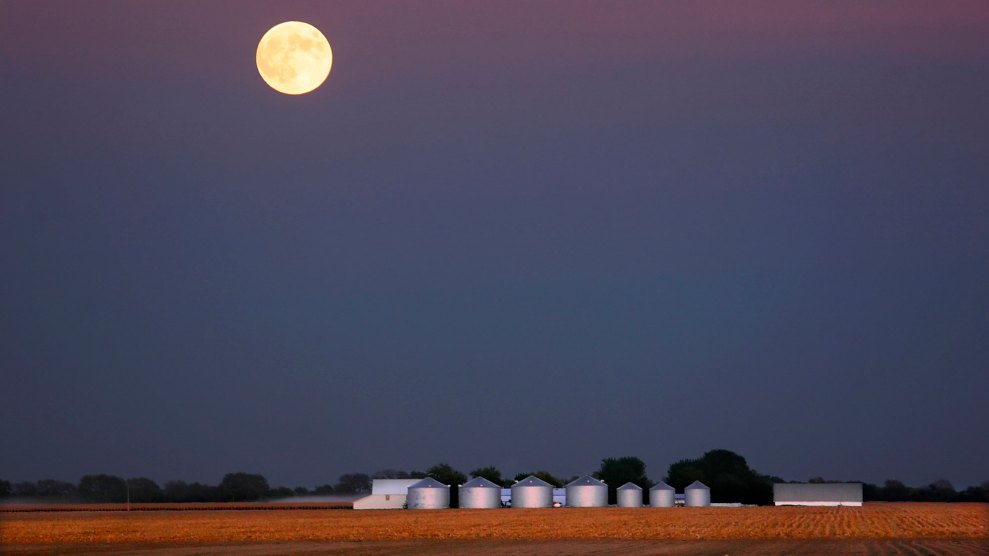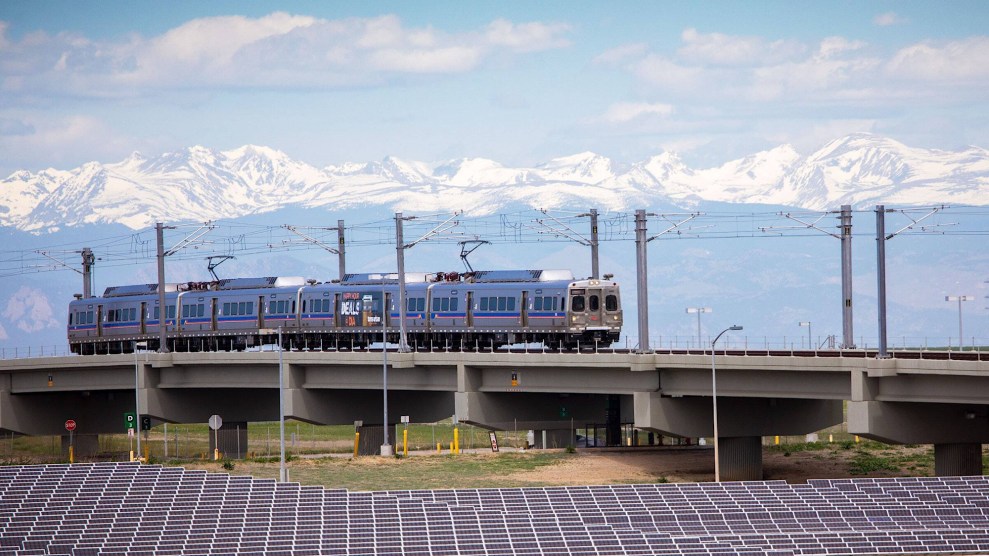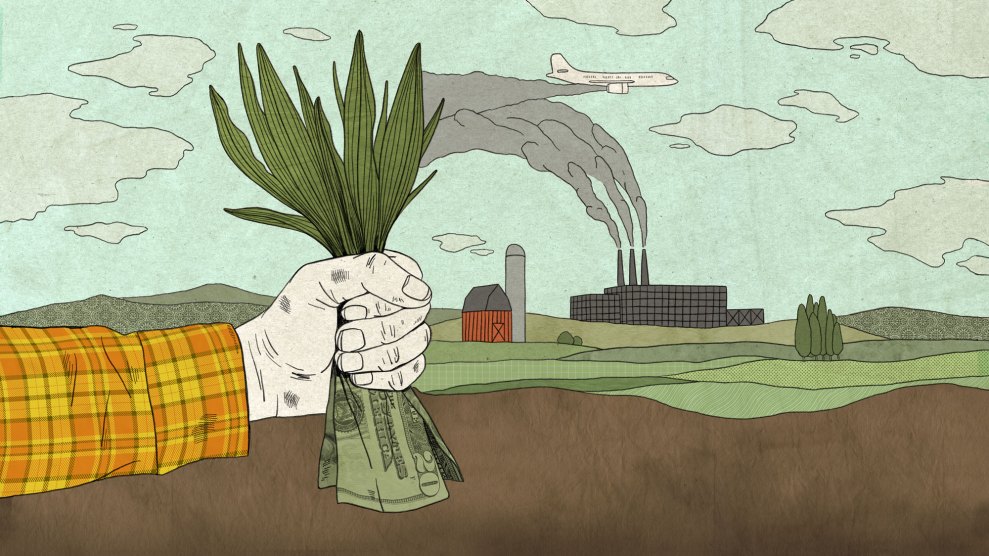
Seth Perlman/AP
This story was a collaboration of the Food & Environment Reporting Network and The American Prospect.
What if all it took to make a dent in agriculture’s contribution to climate change was to pay farmers not to farm?
That’s the theory behind the recent expansion of the Conservation Reserve Program (CRP), a decades-old initiative that has emerged as a central tool in the Biden administration’s effort to achieve net-zero emissions in the agriculture sector.
CRP spends nearly $2 billion annually on payments to farmers who have taken some or all of their acres out of crop cultivation and planted grasses or trees instead. The Farm Service Agency, which administers the program, boasts of a range of benefits for air, water, soil, and wildlife, including reportedly sequestering as much as half of the carbon dioxide emitted in the farming sector each year. Since 2000, the USDA has spent more than $35 billion on the program.
Yet the USDA only contracts CRP land for 10 to 15 years. After that, the vast majority of the land is tilled again for crop production, causing carbon that was stored in the soil to be released back into the atmosphere. The agency doesn’t take this rather significant flaw into account when calculating the program’s carbon benefits.
Expanding CRP is “a start, it’s a stepping stone” in addressing agriculture’s carbon emissions, says Jessica Kochick, a policy organizer with the Land Stewardship Project (LSP) in Minneapolis. But “on a broader scale, the way the government is investing in agriculture is broken,” she says. “It needs to be changed if we’re going to be serious about reducing agriculture’s role in producing greenhouse gases.”
The long-standing regulatory debate surrounding farming’s carbon emissions may seem like inside Washington baseball. But today it serves as a critical backdrop to the Biden administration’s search for ways to lessen agriculture’s contributions to climate change.
The farming sector contributes about 10 percent of all of the nation’s greenhouse gas emissions, mostly from animal-produced methane and fertilizers. Biden said early in his presidency that he wants the US agriculture sector to be the first in the world to achieve net-zero emissions, and conservation programs have been one of the regulatory tools of choice to get there. Secretary of Agriculture Tom Vilsack has endorsed Biden’s vision, saying his goal in getting more land in conservation is “to make sure that there is profitability in whatever it is we create so that the right set of incentives are in place.”
But after decades of growing public skepticism about government spending on farmers, from the annual outlay of crop subsidies to the billions spent on pandemic farm relief, the argument that the agriculture sector needs a helping hand solving environmental problems it helped to create leaves some unconvinced.
More critically, the science suggests that conservation programs alone don’t have the carbon impact needed to steer agriculture in a more sustainable direction in the coming decades.
“More wind, more solar [on farms], that’s going to [have] a really big impact on climate change, rather than trying to sequester carbon in the soil,” says Anne Weir Schechinger, an analyst at the Environmental Working Group (EWG). “The science is not quite there yet on how much those conservation practices can actually sequester.”
When CRP was established in 1985, its goals were to curtail soil erosion in the Great Plains, and stabilize crop prices for farmers by taking some land out of production. In its first year, USDA hoped to enroll 45 million acres, but the program has never come close to that, peaking in 2007 at 36.8 million acres. In return for idling their land, the USDA pays farmers a yearly sum per acre enrolled in the program; this year, the average rent per acre is around $83.
The economic incentive for farmers to participate in CRP is mixed. On the one hand, landowners are collecting a government payment to do little but plant grass cover or trees. The USDA’s Natural Resources Conservation Service imposes limits on what can be done with CRP land. Just holding conserved land allows farmers to add to their income, too. More than half of CRP enrollees use their land for recreational purposes like charging others to hunt. “[H]unting fees motivate landowners to install wildlife-friendly land-use practices,” wrote the USDA in 2008.
The passive income means some landowners can treat CRP as a “community retirement program,” says Daniel Bigelow, an economics professor at the University of Montana, who formerly worked for the USDA’s Economic Research Service.
That reasoning drew Donn Teske, a farmer in Pottawatomie County, Kansas, and president of the Kansas Farmers Union, to CRP 20 years ago. His decision to enroll was “pure economics.” He had “crappy farm ground” that wasn’t well suited for crops, and CRP offered a better deal.
“I did a cash flow on what I could do by cropping it and what I could do with CRP, and it was kind of a no-brainer,” he says.
However, with commodity prices at an eight-year high, farmers have naturally responded by planting as many of their acres as possible with money-making crops like corn, soybeans, and wheat. This comes just as the Biden administration seeks to put a record amount of land in conservation.
“Enrolling acres in times where prices are good [is] a time-honored CRP struggle,” says Silvia Secchi, a professor of environment and geography at the University of Iowa.
Over time, the USDA, and now the Biden administration, has attempted to address this issue by raising CRP payments. But the USDA’s data show that doesn’t really work. CRP enrollment has fallen steadily for years, even as average rental rates have increased dramatically.
In theory, farmers also have a less financially motivated reason to enroll in CRP: being good stewards of the land. Since 1998, the USDA has measured the environmental impact of CRP with a metric called the Environmental Benefits Index (EBI). The tool assigns a point value to benefits like improving water and air quality, enhancing wildlife habitat, and reducing soil erosion. The more points landowners rack up in their proposal, the more likely they are to get a CRP contract.
Using this tool, USDA has found that CRP successfully reduced wind, water, and soil erosion, and in one year, the program generated more than $700 million in wildlife-related benefits. Land enrolled in CRP has virtually no nutrient loss, a major benefit for areas plagued by farm-field runoff into local waterways.
The EBI matrix is not especially rigorous, however, experts say. The value placed on different environmental benefits is in part determined in cooperation with outside interests, like conservation groups, and any changes are highly political. So it ranked as a major update when, in 2006, an additional line appeared in the EBI: carbon sequestration.
Though carbon sequestration is a “tiny fraction” of CRP’s EBI score, according to Bigelow, the USDA has heavily advertised the carbon benefits of the program ever since. In 2016, the agency reported that from 2010 to 2014, the program had “sequestered an average of 49 million metric tons of CO2 equivalent per year,” which it said was tantamount to “removing 9 million cars from the road annually.” That’s more than half of the agriculture sector’s annual carbon dioxide emissions, which topped 85 million metric tons in 2018.
Those are major benefits for a program that requires farmers to do next to nothing. But experts say the USDA’s carbon accounting has serious flaws.
One issue is that most CRP land is tilled soon after farmers’ 10-to-15-year contracts with the USDA end. As many as 80 percent of farmers put their CRP land back into crop rotation, mostly to grow those lucrative commodity crops: corn, soy, and wheat. One study estimated that just 3 percent of CRP land stayed in some form of conservation after the CRP contract ended.
And once that conserved land is tilled, any sequestered carbon is released back into the atmosphere. “Even a single tillage event can rapidly destroy an accumulated soil [carbon] benefit,” said one CRP study. The USDA itself has acknowledged this problem: In 2014, the agency wrote that “tilling former CRP lands will lead to a decline in soil carbon stocks, thereby reversing the trend for CO2 uptake from the atmosphere and leading to CO2 emission.”
Teske has observed this firsthand. Over the years, acres that he’s taken out of CRP have gone into the pasture rotation for his cattle herd. But he’s rare among his neighbors; most “tore it up right away” to plant crops if they didn’t re-enroll land in the program, he says.
“It was getting ripped out fencerow to fencerow. It was a shame,” he says. “Whatever [CRP land] was doing for soil sequestration and the environment was gone right away.”
The inherently short-term nature of CRP benefits throws into question any reported carbon benefit of the program, says Secchi. “The fact that there is impermanence of CRP benefits, it’s a big issue if you’re talking about climate,” she says. “The whole [program] is not set up for climate first and foremost.”
There also are scientific limits to CRP’s carbon benefit potential. Soil can’t accumulate carbon indefinitely; it reaches an equilibrium over time. According to researchers from the University of Oxford, “activities that sequester carbon have diminishing rates of return and come hedged with problems.” So, even if CRP contracts were extended, conserved land would only contribute so much to offsetting the farm sector’s carbon emissions; it cannot absorb the total impact of farming and net out all emissions.
By emphasizing carbon sequestration, the USDA also waded into the controversial science of how to calculate soil carbon. While farming practices like planting cover crops and reducing soil tillage have environmental benefits, scientists have found evidence that they do little to increase carbon in the soil. Measuring and monitoring issues have plagued farmers’ efforts to break into private carbon markets with carbon credits derived from sequestration.
The USDA’s calculations of CRP benefits also don’t always add up. In 2016, the year the agency reported CRP’s five-year annual average of 49 million metric tons (MMT) of carbon sequestration from 2010 to 2014, its own data, charted below, showed an annual average of 41 MMT.
Asked to explain this discrepancy, a USDA spokesperson said that the agency also includes “additional [carbon] reduction from reduced fuel and fertilizer use” in its calculation, and that the 2016 report was based on preliminary figures; the agency’s final five-year sequestration average was 48 MMT, not 49.
Figuring out how the USDA measures carbon sequestration is extremely difficult. In reporting this story, I interviewed a dozen experts, none of whom knew how the agency calculated CRP’s carbon benefits. I sent numerous interview requests to agency experts over the course of several months, which were redirected to five different communications staff and political appointees, none of whom ultimately made any expert available to speak in detail about the USDA’s soil carbon accounting or its broader approach to climate change.
An agency spokesperson finally responded that the USDA is in the process of aligning its CRP carbon sequestration calculations with the Intergovernmental Panel on Climate Change’s (IPCC) soil carbon methodology. Until then, the agency is using several different methodologies to calculate CRP’s soil carbon benefits from trees and grass cover and wetlands.
Stephen Ogle, a professor at Colorado State University and a leader in researching agricultural land use and greenhouse gases, told me over email that the IPCC guidelines are “the closest set of guidance to a gold standard in the field.”
The agency will also this summer award contracts for an initiative, announced in May, to “survey, sample and measure the climate benefits” of CRP land. The program will set up a network of CRP carbon measurement sites, the USDA says. But the selected projects will last up to five years. It remains unclear when the agency will update its carbon calculation process.
At the heart of the controversy around CRP is a philosophical question: How much do farmers owe the broader public when it comes to tackling the climate crisis? Farming is unlike other regulated industries. Where in some sectors a workplace, like a manufacturing plant, might be the main source of pollution, for many farmers their workplace is also their home, long-term investment, inheritance, tax shelter, or all of the above. Knocking down farming’s carbon footprint requires the cooperation of hundreds of thousands of private landowners, most of whom are accustomed to a friendly policy ecosystem and abhor government intervention.
Agriculture reformers, particularly green groups and academics who want the USDA to pursue more aggressive farm regulation, are unconvinced that the CRP’s incentive-driven model can effectively address farming’s climate impact. These kinds of opt-in environmental programs, they say, have repeatedly failed to protect waterways and communities from the negative effects of modern farming.
“We have decades of research showing that voluntary is not enough,” says EWG’s Schechinger. “The voluntary things that are being proposed with climate are also probably not going to do a whole lot to mitigate climate change.”
But it is exactly the voluntary nature of CRP and related initiatives that makes the USDA’s conservation programs so appealing to their supporters, an unlikely coalition of farm, environment, hunting, and conservation groups. A more punitive policy approach would be politically unfeasible, and ultimately less effective than using payments and other incentives to entice farmers to enroll in existing USDA programs, they say.
“It’s not wrong to want farmers to farm in a way that decreases the externalities,” says Eric Deeble, policy director of the National Sustainable Agriculture Coalition. “But farmers are in the business of producing food, which is essential, and an income for themselves. It is a challenge to strike the right balance between requiring individuals to adopt practices that we might think would improve [environmental] quality, without offering in exchange something that helps to make up for the potential lost income.”
Though it won’t accomplish net-zero farm emissions on its own, expanding CRP is one of many tools that should be deployed in the effort to achieve a lower-carbon economy, experts say.
“[T]he key point here is that it is [a] short-term solution, providing a bridge to reduce emissions in the next decade or so while decarbonization of the electrical grid and other mitigation measures in the energy sector continue to mature,” says Ogle.
But seen another way, this philosophy justifies yet another government handout to farmers. While they do face structural barriers in the form of an increasingly consolidated market, farmers remain an overwhelmingly white, wealthy occupational group that holds significantly more economic and social power than, say, their employees—or, indeed, than the average American household. In 2020 alone, farms received $46 billion in federal aid between emergency pandemic assistance and traditional farm subsidies. EWG has tracked $425 billion in farm subsidy spending over the past 25 years.
Given that, some argue that a more effective way to reduce farming’s carbon impact would be to aggressively regulate the worst polluters, rather than rely on a carbon market or conservation programs to offset farming’s negative impact.
“If we’re not willing to scuttle this super-inefficient system, where we subsidize the overproduction of fossil fuel–intensive crops that then are used to produce cheap beef, which causes a lot of methane emissions, at least we should not do more of the same in terms of these impermanent contracts that don’t provide the carbon benefits that we require,” says Secchi.
To make conservation programs more rigorous on climate, experts say the USDA could invest more in longer-term or permanent land idling, and in offshoots of CRP that offer longer-term contracts.
So far, though, the Biden administration and many members of Congress have bought into the incremental approach. In April, the USDA announced an effort to enroll four million new CRP acres, a 20 percent increase, by enticing farmers with higher rental payments and other financial incentives. Vilsack is specifically promoting CRP’s carbon impact, promising to put “producers and landowners at the center of climate-smart practices that generate revenue and benefit our planet.”
And the Senate in late June passed the Growing Climate Solutions Act, the first climate mitigation bill for agriculture, which would build out infrastructure to support carbon markets where farmers could sell credits from carbon sequestered in the soil. Such markets are highly controversial: Dozens of food, farm, and environmental groups have called them a “scam” that would only serve to shore up the most powerful companies and farms.
“Agriculture can absolutely play a part in reducing greenhouse gas pollution, but not like that,” says LSP’s Kochick. With carbon markets, the USDA and policymakers are “still looking for the easiest solutions that continue to benefit the current status quo.”












